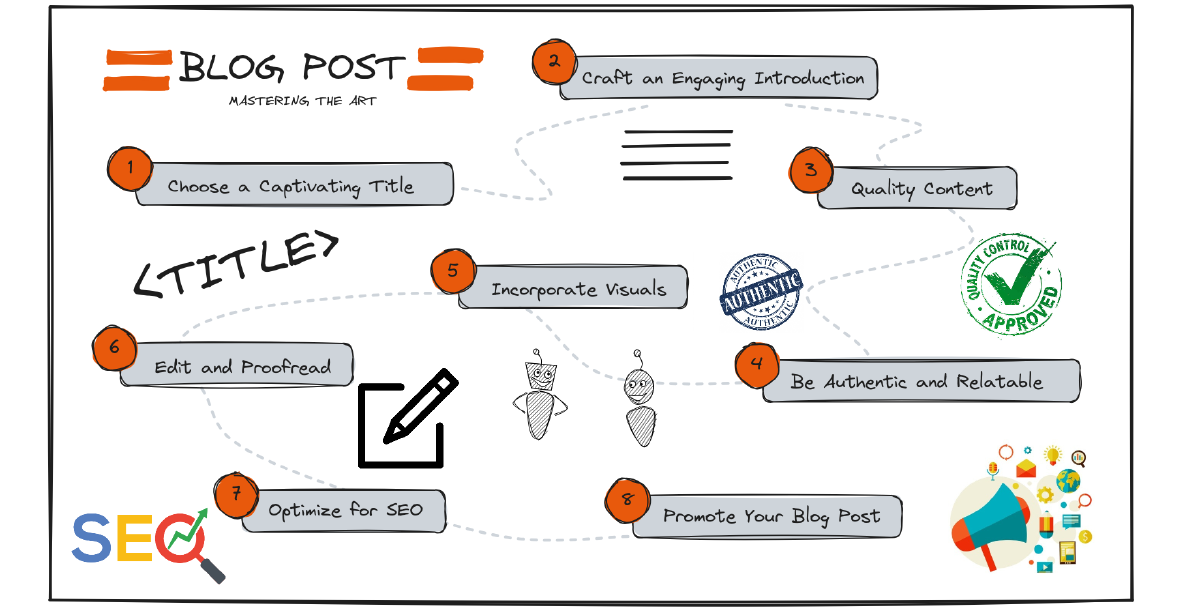In the vast landscape of the internet, where content is king, the ability to craft a compelling blog post is a valuable skill. Whether you’re a seasoned blogger or just starting, there are certain principles that can elevate your writing and engage your audience. We’ll explore the elements of a good blog post and provide tools and tips on how to create content that resonates with your readers.
Principles for writing a good blog post#

Writing a good blog post goes beyond mere words on a screen; it’s an art form that demands a delicate balance of creativity, strategy, and authenticity. In this age of content saturation, where the competition for readership is fierce, understanding and applying principles for writing a good blog post can be the key to standing out in the digital crowd.
- Choose a Captivating Title
- Craft an Engaging Introduction
- Create Quality Content
- Be Authentic and Relatable
- Incorporate Visuals
- Optimize for SEO
- Edit and Proofread
- Promote Your Blog Post
Tools#
There are numerous tools available that can assist you in various aspects of writing and enhancing your blog posts. Here’s a list of tools categorized based on different stages of the blogging process:
Writing and Editing#
- ChatGPT: a language model developed by OpenAI based on the GPT-3.5 architecture, capable of understanding and generating human-like text across a wide range of topics.
- Quillbot: is an AI-powered paraphrasing tool that utilizes machine learning to rewrite and rephrase text, helping users generate alternative versions of sentences or paragraphs while maintaining context and meaning.
- Jenni.ai: is an AI writing assistant that helps with essay writing, research papers, and more.
- Languagetool:
- Grammarly: A powerful writing assistant that checks for grammar and spelling errors, suggests improvements, and enhances overall writing style.
- Hemingway Editor: Highlights complex sentences, suggests simpler alternatives, and helps improve the readability of your content.
- Google Translate: is an online language translation service provided by Google, enabling users to translate text or speech from one language to another with the aid of machine learning algorithms.
Creating Visuals#
- Canva: Design eye-catching graphics, featured images, and social media visuals for your blog post.
- Excalidraw: is an open-source collaborative drawing tool that allows users to create diagrams, sketches, and visualizations in real-time with simplicity and ease of use.
- Unsplash: Access high-quality, royalty-free images to enhance the visual appeal of your blog post.
- Svg Repo: is a platform that provides a vast collection of high-quality SVG icons for free, offering a valuable resource for designers and developers seeking customizable vector graphics for various projects.
Content Distribution and Analytics#
- Medium: Republish your blog posts on Medium to reach a wider audience and tap into a different readership.
- Buffer: Schedule and manage social media posts to promote your blog content effectively.
- Bitly: Shorten and customize URLs for sharing on social media, while also providing tracking analytics.
- Google Search Console: is a free web service provided by Google that allows website owners, administrators, and webmasters to monitor and optimize the presence of their websites in Google’s search results. Formerly known as Google Webmaster Tools, the platform was rebranded as Google Search Console in 2015
- Google Analytics: Monitor the performance of your blog post, track visitor behaviour, and gain insights into your audience.
Remember, while tools can significantly enhance your blogging experience, the most crucial element is your creativity and authenticity. Experiment with different tools to find what works best for your writing process and style.
